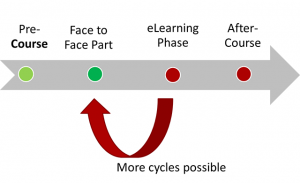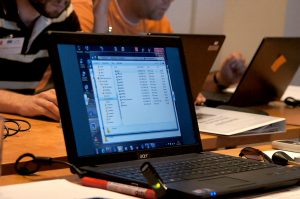
Blended Learning Cycles
We understand the term “Blended Learning” as a special type of course that is split in face-to-face teaching and eLearning.
We propose that this should start in a pre-phase (face to face) – followed by (minimum one or) several cycles of face-to face and eLearning parts.
Finally there should be a face-to-face event (covering tests and assessments).
The picture demonstrates the logical flow of the creating of a Blended Learning Course.
What does “eLearning” mean in this context?

Technology Enhanced Learning with a laptop
In the context of Blended Learning this means a learning phase apart from the onsite teaching. This can be at home, or using a CD-ROM to practice some specific knowledge.
In Austria, for example, the training for the driving licence is a typical Blended Learning setting:
- Basic instructions are done by a teacher in the driving school (onsite teaching)
- The training of rules, behavior in specific traffic situations or the practice of common knowledge to drive a car is done with a CD-ROM. This can be done at the driving school (using their computer equipment) or at any place at any time where the learner has access to a digital device displaying the content of the CD-ROM.
The learnong for the driving license is a typical example for a Blended Learning setting.
eLearning is an obsolete term
eLearning is missused often and reduced to “learning with the internet”. This approach is completly wrong and leads to a messing-up of the term eLearning. Therefore it should be replaced by more precise descriptions.
A term replacing eLearning is Technology Enhanced Learning. It characterices the use of multiple devices (laptops, computers, tablets or smart phones) for the learning outside of the traditional onsite setting (teacher and learners in a room).

